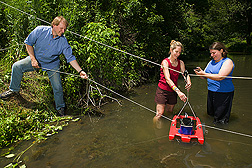This page has been archived and is being provided for reference purposes only. The page is no longer being updated, and therefore, links on the page may be invalid.
|
Read the magazine story to find out more. |
|
|
Research Seen To Improve the Chesapeake
By Sharon DurhamNovember 21, 2006
No one doubts that the Chesapeake Bay has been stressed by animal and crop production--as well as by regional development--across its entire watershed, a landmass of 64,000 square miles. For some time, Agricultural Research Service (ARS) scientists and others have been investigating ways to mitigate or prevent harm from farming practices. ARS is the chief scientific research agency of the U.S. Department of Agriculture (USDA).
The good news is: There’s been progress. The bay’s total estimated levels of phosphorus fell from 27.1 million pounds of phosphorus in 1985 to 19.5 million in 2002. The nitrogen level fell from 338 million pounds in 1985 to 278 million in 2002.
To further reduce runoff into the bay, soil scientist Greg McCarty with ARS’ Hydrology and Remote Sensing Laboratory in Beltsville, Md., has done extensive research on the use of riparian buffer zones to reduce the amount of nutrients getting into waterways. These buffer zones—wooded or grassy areas in wetlands and along streambanks—help filter out pollutants and excess nutrients.
Unfortunately, the nutrient reductions made to date may still be insufficient because, in the summer of 2005, there was almost no oxygen in 3 percent of the bay's waters, and 21 percent had low levels, according to the multiagency Chesapeake Bay Program. This was the lowest oxygen level detected in the bay's central region since CBP monitoring began in 1984.
Now, in addition to scientific studies by state and federal agencies to improve the bay, there is a USDA effort under way called CEAP (the Conservation Effects Assessment Project) tapping watershed researchers nationwide to assess the benefits and value of conservation efforts. As part of the CEAP project, the researchers are using historical data and monitoring of current conditions to estimate the impact of conservation practices like riparian zones and cover crops on environmental issues such as quality of the water entering the bay.
Read more about this research in the November issue of Agricultural Research magazine.


